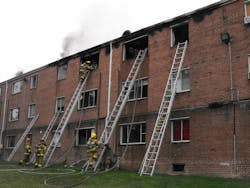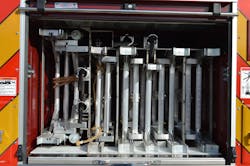The Apparatus Architect: Apparatus Design & Ground Ladders
Over the years, fire departments long have recognized the importance of carrying portable ground ladders on their apparatus. Engine company units typically have been equipped with a minimum of three ladders, including a 24-foot extension, a 14-foot roof and a 10-foot folding ladder.
Back in the day, communities that didn’t require an aerial device would outfit one or more apparatus with additional ground ladders to provide secondary ladders for use on the fireground. Apparatus that were outfitted with the nominal NFPA 1901: Standard for Automotive Fire Apparatus complement from this period (228 feet in various lengths) were termed quads, because they only lacked the aerial device to qualify as a quint apparatus.The basics, and more
As defined in NFPA 1901, a quint consists of a fire pump, a booster water tank, hose and portable ladders, with the fifth element being the aerial device itself, whether it be an aerial device or a platform. A quad consists of a fire pump, a booster water tank, hose and a complement of portable ladders but no aerial device.
Early quints typically were midship-mounted aerial ladders that had working heights of 75, 85 or 100 feet, with the fire pump located under the turntable area. The hosebed was located under the bedded ladder, and the entire length of the body was utilized for ground ladder banking. Water tank size generally was 200–300 gallons, and the tank was located just behind the turntable, with four to six enclosed compartments on each side of the body.
Quint apparatus of this era strictly were packaged to provide all of the quint features with pre-engineered designs. American LaFrance, Maxim Motors and Seagrave produced midship quints that used this blueprint.
Apparatus engineering during this period produced various models of quints that had minor variations; the space that was required to mount a fire pump and to accommodate supply line hose was well-defined. Most all departments specified the NFPA 1901 ground ladder complement, which provided at least four extension ladders as well as roof and wall ladders in various lengths.
When midship tower ladders were introduced during the mid-1960s, many were built without a fire pump, tank and hosebed based on the desire to keep these heavier vehicles as short as possible yet provide sufficient body compartments and ground ladder storage. Several manufacturers designed their tower apparatus to include side-mounted ground ladders. As tandem-axle chassis became more commonplace, initial concerns about rear-axle weight ratings no longer were an issue.
Because of the increased weight that was imposed by the tower ladder and multiple outrigger configurations, tandem-axle apparatus were required when a fire pump and water tank were added to the equation. In some cases, the difference between a quint and a nonquint tower ladder was an increase in wheelbase and overall length, along with heavier front- and rear-axle components, to safely carry the anticipated in-service weights. Table 12.1.2 in NFPA 1901 provides some guidance for the minimum tool and equipment weight for aerial devices of 2,500 lbs. Based on your department’s operational requirements and current equipment cache, the 2,500-lb. allowance might not be sufficient to account for the weight of your equipment.
Over the years, NFPA 1901 minimum ground ladder complements declined from 228 feet to the current 85 feet for a quint and 115 feet for any other aerial device. Ultimately, ladder complements must be determined by a department based on the buildings that are in its response district, apparatus assignments, operating guidelines and past fireground experiences.The reduction in the minimum ground ladder requirements largely was influenced by the popularity of quints and departments’ increased concerned with the gpm rating of the fire pump, water tank size and hosebed capacity. All of these components require space and weight, which detract from the ability to bank ground ladders, particularly any two-section ladder that’s longer than 24 feet.
Quint packaging on single-axle apparatus is particularly critical, because the front- and rear-axle components are limited to current weight ratings of 24,000 lbs. and 35,000 lbs., respectively. Several years back, tower ladder apparatus were built with the front axle rated at 21,500 lbs. and the tandem rear axle rated at 52,000 lbs. Because of the additional weight that’s imposed by diesel engine emission components, tower components and fire pump systems, current midship tower ladders can require a 24,000-lb. front axle and a 62,000-lb. rear axle, along with counterbalance weight to carry the in-service weight of the vehicle.
The result is that many apparatus are loaded to 97 percent of the gross vehicle weight rating when they are placed into service. This scenario led to new apparatus that are overweight when fully equipped with hose, tools, equipment and personnel. When developing specifications for a new aerial device, particularly any tower ladder apparatus, committees should consider carefully the need to provide a fire pump, along with other engine company equipment on the vehicle. Besides increasing the cost of the vehicle, the space that’s required for these components reduces the available area for ground ladder banking.
Midmount vs. rear-mount
When compared with midmount tower ladders, rear-mount aerial devices have higher travel heights. Because of the length of the fully retracted ladder sections, they have less effective scrub area as a result of the increased setback from the building frontage. Apparatus positioning is critical for a 100-foot, rear-mount aerial tower to access the lower portions of the structure. Rear-mount quints’ platform waterway is located at the centerline of the turntable rotation, which reduces the available space for banking ground ladders.
Midmount tower ladders generally have a greater operational range because of the height of the turntable from the ground. When they are properly positioned, several models can lower the platform on the ground within the length of the retracted ladder sections. This greatly increases the versatility of the device when compared with a rear-mount tower. Based on body packaging, with few exceptions, this reduces the available compartment space for equipment storage and ground ladder banking when a quint configuration is desired on a midmount tower ladder. With either design, the quantity of ground ladders that you wish to carry on an apparatus is determined by the available space that’s under the turntable and that’s outside of the body based on the water tank size, depth of the body compartments, amount of supply line that’s carried and the location of other components, such as a hydraulic oil reservoir and the waterway piping.
Ground ladder storage areas that are on aerial apparatus largely are dependent on the packaging of other chassis and body components. The banking arrangement of flat or on beam positions also might be influenced based on the maximum travel height of the apparatus and the preferred method for personnel to deploy and carry ground ladders.One aluminum ground ladder company lists in its catalog a two-section, 35-foot extension ladder that has a closed length of 20 feet, 1 inch and a weight of 139 lbs. A three-section version of the same ladder is 15 feet, 8 inches long and weighs 170 lbs. A truss-style version of the two-section, 35-foot ladder has a slightly higher banking thickness but is only 2 lbs. heavier than the solid-beam, pumper-style extension ladder. The ground ladder banking on any aerial device can be determined in conjunction with the apparatus manufacturer’s body engineering group and can provide suggestions to enable your apparatus committee to maximize the available space to carry portable ladders.
Take steps
Over the years, quint apparatus of any design has contributed to the reduction of ground ladders that are available on the fireground. In some instances, the importance of fire pump ratings, water tank size, and compartmentation for tools and appliances relegate ground ladder complements to the extent that only two extension ladders and several roof ladders are the norm. Well-designed aerial apparatus should carry sufficient ground ladders to cover all four sides and elevations of the structures that are typical in your response district. If your current ladder company apparatus can’t provide these resources, then consideration should be provided to have additional ladder apparatus assigned to the response.
As the old fire service proverb goes, “You can stretch a hose, but you can’t stretch a ladder.” While operating on the fireground, the proper placement of ground ladders is vital for the safety of personnel as well as any potential victims who are inside of the building. No other agency that responds to your incidents carries portable ladders. Make sure that you preplan your first-due area to ensure that your rigs carry the correct complement of ground ladders.
About the Author

Tom Shand
TOM SHAND, who is a Firehouse contributing editor, is a 36-year veteran of the fire service. He works with Michael Wilbur at Emergency Vehicle Response, consulting on a variety of fire apparatus and fire department master-planning issues. Shand is a member of the Firehouse Hall of Fame.
Michael Wilbur
MICHAEL WILBUR, who is a Firehouse contributing editor, retired as a lieutenant in FDNY, where he was last assigned to Ladder Company 27 in the Bronx. He has served on FDNY's Apparatus Purchasing Committee and consults on a variety of apparatus-related issues around the country. Wilbur is a member of the Firehouse Hall of Fame. For further information, access his website at www.emergencyvehicleresponse.com.




